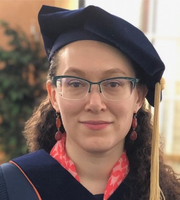Neutron Skin Measurement
A new measurement, presented by UVa graduate and postdoctoral scholar Caryn Palatchi at the APS Division of Nuclear Physics annual meeting, reveals that heavier types of calcium nuclei are relatively thin-skinned. The result is the first electroweak measurement of the neutron skin in a medium-weight nucleus, and provides a new benchmark for models of nuclear structure.
The measurement was made on Ca-48, and isotope of calcium with 20 protons and 28 neutrons. The more numerous neutrons are expected to fill a larger volume than the protons, hence forming a “neutron skin” on the nucleus. The thickness of this skin is sensitive to poorly measured but fundamental parameters of nuclear matter, and has been never before been reliably determined. The researchers used a high precision measurement of a very subtle effect to get at this information. The scattering of electrons from neutrons depends on the electron spin in a way that violates mirror symmetry: two reactions which are otherwise identical mirror images of each other will have slightly different scattering rates due to the “weak” nuclear force. A scattering asymmetry of about 2.6 parts per million was measured to about 4% of itself, resulting in a precision of about 0.025 millionths of a nanometer on the skin.
The measurement is part of a series of experiments aimed at teasing out how protons and neutrons are distributed in dense nuclei. Earlier this year, the Pb208 Radius EXperiment (PREX) confirmed that lead-208 nuclei have a relatively thick skin. The new result in Ca-48 is especially striking given the relatively thick skin found in lead, a combination which is not easily accommodated by many models of nuclear structure.
The measurement also featured the highest precision result ever achieved in electron beam polarimetry. UVa students Allison Zec and Amali Premathilake operated and analyzed results from the Compton electron polarimeter, achieving a precision of 0.52% on the beam polarization. Other important contributions from UVa included GEM chambers built by Prof. Nilanga Liyanage and UVa student Siyu Jian to calibrate the electron spectrometers.
Professor Kent Paschke is co-spokesperson for the PREX/CREX collaboration.
Further reading:
 Physics at Virginia
Physics at Virginia




